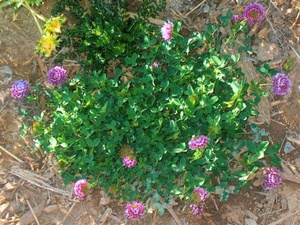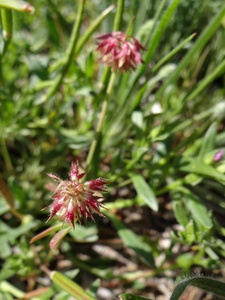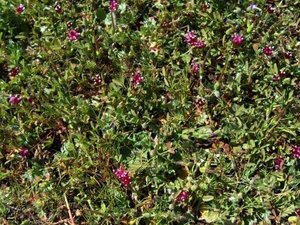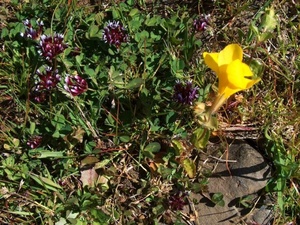Clover species are annual or perennial forbs in the Trifolieae tribe of the Faboideae subfamily of the pea family (Fabaceae). Other members of the Faboideae subfamily of the pea family include peas, milk vetch, lupines, scurfpeas, trefoils, pagoda trees, locust trees, camel thorn, rattlebox.
The genusTrifolium comprises the "true" clovers, but other species in the same tribe are commonly called burclovers or sweetclovers and share similar three-part leaves; this page covers the entire tribe.
Many clovers are native to Woodland, and two non-native clovers are officially classified as invasive weeds here.
Clovers are a larval host plant for many local butterflies, including the Queen Alexandra's sulphur, orange sulphur, clouded sulphur, Persius duskywing, gray hairstreak, western cloudywing, Mexican cloudywing, and northern cloudywing.
Some plants that are not at all closely related to clovers are often called clover. For example, waterclover is actually a fern, and owl's clovers are hemiparasitic plants in a different plant family from clover.
Clover Street, West Clover Street, and Clover Court in western and central Woodland are all named for our local clovers.
Native to Woodland
Perennials
 Cow Clover (Trifolium wormskioldii) blooms in a garden and gets photobombed by Hairy Gumplant (Grindelia hirsutula). Photo by queerbychoice.
Cow Clover (Trifolium wormskioldii) blooms in a garden and gets photobombed by Hairy Gumplant (Grindelia hirsutula). Photo by queerbychoice.
Cow Clover (Trifolium wormskioldii), also called Springbank Clover, is the only perennial clover native to Yolo County. It is native to all of Woodland, all of Davis, and all of West Sacramento, and east of the Dunnigan Hills as far as Zamora, but only in the Sacramento Valley, and not as far west as Monument Hills. It grows about four inches tall and spreads to form patches about three to four feet across. Its foliage dies back to the ground every winter, but its roots survive for quite a few years and produce new foliage each spring. It prefers full sun and usually grows in wetlands.
Annuals
Indian Rancheria Clover (Trifolium albopurpureum) is native to very nearly all of Woodland (maybe not some of the industrial area in the northeast part of town) and the western three quarters of Davis, as well as the Dunnigan Hills and nearly all parts of Yolo County to the west of those three locations (minus the Capay Valley). It grows about six inches tall. It prefers full sun or partial shade and usually grows in dry areas but occasionally grows in wetlands.
Notchleaf Clover (Trifolium bifidum), also called Pinole Clover, is native to all of Woodland and very nearly all of Yolo County (minus the small rain shadows directly east of the foothills). It prefers full sun or partial shade and grows only in dry areas.
 Tree Clover (Trifolium ciliolatum) in a garden in Woodland. Photo by queerbychoice.
Tree Clover (Trifolium ciliolatum) in a garden in Woodland. Photo by queerbychoice.
Tree Clover (Trifolium ciliolatum) is native to all of Woodland, all of Davis, and the northeastern third of West Sacramento, as well as most of the rest of Yolo County (minus the small rain shadow in the Capay Valley directly east of Blue Ridge and the small rain shadow directly east of the Capay Hills). It is often found on slopes. It prefers full sun and grows only in dry areas.
Olive Clover (Trifolium columbinum) is native to all of Woodland, all of Davis, and the northern half of West Sacramento, as well as most of the rest of Yolo County. It grows only in dry areas.
 The reddish purple flowers of Pale Sack Clover (Trifolium depauperatum) emerge from among invasive, non-native filarees on Table Mountain. Photo by queerbychoice.
The reddish purple flowers of Pale Sack Clover (Trifolium depauperatum) emerge from among invasive, non-native filarees on Table Mountain. Photo by queerbychoice.
Pale Sack Clover (Trifolium depauperatum), also called Cowbag Clover, is native to all of Woodland and nearly all of Yolo County (minus the small rain shadow in the Capay Valley directly east of Blue Ridge and the small rain shadow directly east of the Capay Hills). It is equally likely to grow in wetlands or non-wetlands.
Bull Clover (Trifolium fucatum), also called Sour Clover, is native to all of Woodland and nearly all of Yolo County (minus the small rain shadows directly east of the foothills). It prefers full sun and usually grows in dry areas but occasionally grows in wetlands.
Pinpoint Clover (Trifolium gracilentum) is native to all of Woodland, all of Davis, and most of West Sacramento (particularly the areas around the Sacramento River and the Sacramento Deep Water Shipping Channel), as well as the entire part of Yolo County east of the Dunnigan Hills, plus the Sacramento Valley as far west as Monument Hills, and scattered patches in the Yolo County foothills, the Capay Hills, and the eastern slopes of the Dunnigan Hills. It prefers full sun and grows only in dry areas.
Saline clover (Trifolium hydrophilum) is native to a small portion of southeastern Woodland (Spring Lake and east of County Road 102 from it), the eastern third of Davis, and all of West Sacramento, as well as all portions of Yolo County to the east of Davis and Woodland. It is equally likely to grow in wetlands or non-wetlands.
Small Head Clover (Trifolium microcephalum), also called Hairy Clover, is native to all of Woodland, all of Davis, and the northeastern quarter of West Sacramento, as well as Knights Landing and nearly all parts of Yolo County west of Woodland, Davis, and Knights Landing (minus the Capay Valley). It prefers full sun or partial shade and is equally likely to grow in wetlands or non-wetlands.
Thimble Clover (Trifolium microdon), also called Valparaiso Clover, is native to all of Woodland, all of Davis, and most of West Sacramento (particularly the areas around the Sacramento River and the Sacramento Deep Water Shipping Channel), as well as most of the flatlands east of Monument Hills, east of the Dunnigan Hills, and south of Knights Landing, plus scattered patches in the Yolo County foothills. It grows only in dry areas.
 Variegated Clover (Trifolium variegatum) with a Yellow Seep Monkeyflower (Mimulus guttatus) on Table Mountain. Photo by queerbychoice.
Variegated Clover (Trifolium variegatum) with a Yellow Seep Monkeyflower (Mimulus guttatus) on Table Mountain. Photo by queerbychoice.
Variegated Clover (Trifolium variegatum), also called Whitetip Clover, is native to all of Woodland, all of Davis, and all of West Sacramento, and most of the rest of of Yolo County (minus the rain shadows directly east of the foothills). It prefers partial shade and is equally likely to grow in wetlands or non-wetlands.
Tomcat Clover (Trifolium willdenovii) is native to Woodland and all of Yolo County. It prefers full sun and usually grows in wetlands.
 Tomcat Clover (Trifolium willdenovii) in a garden in Woodland, along with Tufted Poppies (Eschscholzia caespitosa). Photo by queerbychoice.
Tomcat Clover (Trifolium willdenovii) in a garden in Woodland, along with Tufted Poppies (Eschscholzia caespitosa). Photo by queerbychoice.
Native to Yolo County
Bearded clover (Trifolium barbigerum) is not native to Woodland but is native to the northern half of West Sacramento and in the Yolo Bypass from West Sacramento northward to just short of Knights Landing. It usually grows in wetlands.
Branched Indian clover (Trifolium dichotomum) is not native to Woodland but is native to the Yolo County foothills, including the Capay Hills. It grows only in dry areas.
Few-flowered clover (Trifolium oliganthum) is not native to Woodland but is native to the Yolo County foothills (excluding the Capay Hills). It grows only in dry areas.
Non-Native
Invasive Species
Bur Clover (Medicago polymorpha) is an invasive weed from the Mediterranean region. It is an annual with yellow flowers that turn into burred fruiting bodies and often get firmly lodged in people's socks. The foliage is eaten as a salad green in parts of China and in some indigenous communities in Mexico.
Rose Clover (Trifolium hirtum) is an invasive weed from Europe, western Asia, and northern Africa. It is an annual with pink flowers.
Common Garden Weeds
Not all non-native clovers are classified as invasive. Other non-native closers that are common garden weeds here include strawberry clover, crimson clover, white clover, reversed clover, black medick, alfalfa, white sweetclover, annual yellow sweetclover, and yellow sweetclover.
Links
CalScape: Trifolium wormskioldii
Wikipedia: Trifolium wormskioldii
CalScape: Trifolium albopurpureum
Wikipedia: Trifolium albopurpureum
CalScape: Trifolium ciliolatum
Wikipedia: Trifolium ciliolatum
CalScape: Trifolium columbinum
Wikipedia: Trifolium columbinum
CalScape: Trifolium depauperatum
Wikipedia: Trifolium depauperatum
CalScape: Trifolium gracilentum
Wikipedia: Trifolium gracilentum
CalScape: Trifolium hydrophilum
Wikipedia: Trifolium hydrophilum
CalScape: Trifolium microcephalum
Wikipedia: Trifolium microcephalum
CalScape: Trifolium variegatum
Wikipedia: Trifolium variegatum
CalScape: Trifolium willdenovii
Wikipedia: Trifolium willdenovii
CalScape: Trifolium barbigerum
Wikipedia: Trifolium barbigerum
CalScape: Trifolium dichotomum
Wikipedia: Trifolium dichotomum
CalScape: Trifolium oliganthum
Wikipedia: Trifolium oliganthum
California Invasive Plant Council: Medicago polymorpha
Invasive.org: Medicago polymorpha
Wikipedia: Medicago polymorpha
California Invasive Plant Council: Trifolium hirtum
Invasive.org: Trifolium hirtum
Invasive.org: Trifolium incarnatum
Invasive.org: Trifolium repens
Invasive.org: Trifolium resupinatum
Invasive.org: Medicago lupulina


